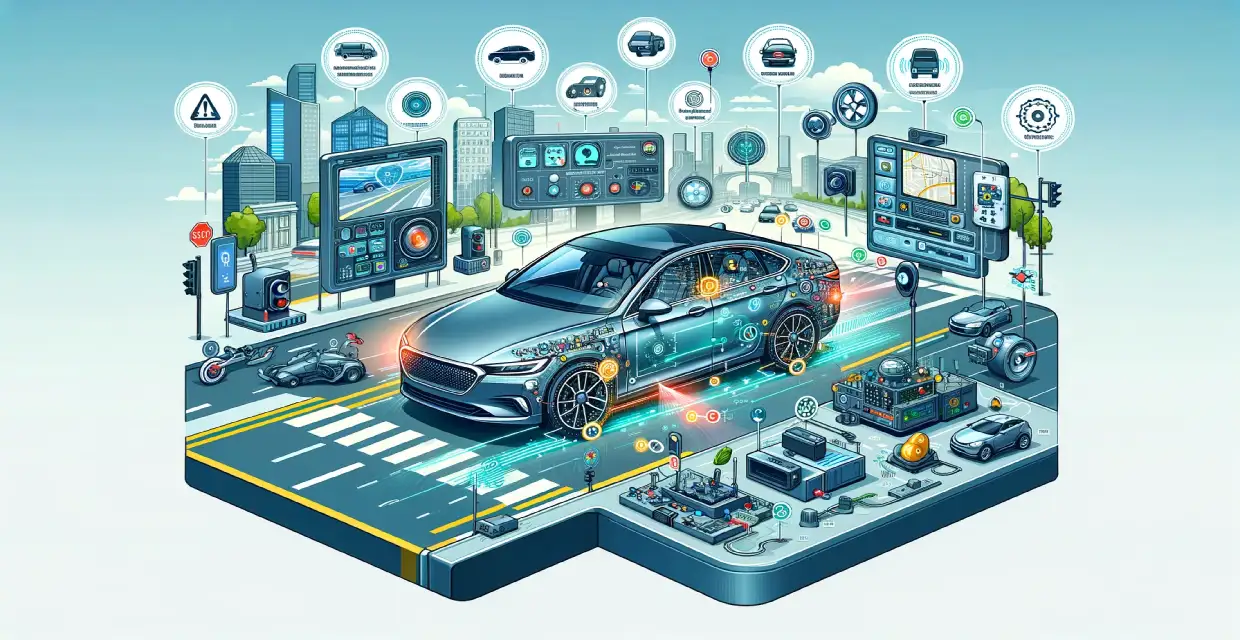

ADAS, or Advanced Driver Assistance Systems, revolutionises vehicle safety, employing sensors and automation for safer driving. Crucial in modern cars, ADAS integrates features like adaptive cruise control and collision avoidance, minimising accidents. Its roots trace back to the 20th century, evolving from early innovations to today's sophisticated technology. ADAS pioneers safety, offering automated assistance for improved road safety.
ADAS consists of various components under its hood. These help it maintain your vehicle safety and automate your safe driving. The components include:
Sensors forming the backbone of ADAS:
Camera Systems: Visual data collection for lane detection, traffic sign recognition.
Radar Sensors: Detecting objects, monitoring blind spots, and facilitating adaptive cruise control.
LiDAR Technology: Precise mapping of surroundings using lasers, crucial for autonomous driving.
Ultrasonic Sensors: Close-range object detection, assisting in parking and collision avoidance.
Processing Units and Control Systems:
ECUs (Electronic Control Units): Managing data flow, controlling various ADAS functions.
AI and Machine Learning Algorithms: Analysing sensor data, improving real-time decision-making.
Software Integration and Functionality: Fusing inputs from sensors, enabling autonomous functions like emergency braking and lane-keeping.
Also Read:- Upcoming Cars in India
These components work synchronously, interpreting information from sensors through AI and machine learning algorithms. Cameras detect lane markings and signs, while radar senses nearby vehicles. LiDAR creates 3D maps, and ultrasonic sensors assist in parking. ECUs process this data, allowing AI algorithms to make split-second decisions, enabling functionalities like automated emergency braking. Software integration coordinates these functions for enhanced safety, making ADAS a critical contributor to modern vehicle safety systems.
Also Read:- How to Drive a Car in Heavy Fog
ADAS brings a whole featurette for your car. Some of these are listed below, though the applications are not exhaustive.
A. Collision Avoidance Systems:
Automatic Emergency Braking (AEB): Instant braking to prevent collisions.
Forward Collision Warning (FCW): Alerts drivers about potential front-end collisions.
Blind-Spot Monitoring (BSM): Detects vehicles in blind spots, warning of unsafe lane changes.
B. Adaptive Cruise Control (ACC) and Traffic Jam Assist (TJA):
C. Lane-Keeping Assist and Lane Departure Warning (LDW):
D. Parking Assistance Systems:
Automated Parking: Helps steer the vehicle into parking spaces autonomously.
Surround-View Cameras: Offers a 360-degree view, aiding in parking and manoeuvring in tight spaces.
E. Pedestrian Detection and Cyclist Safety Features:
Also Read:- Best Car for Long Distance Trip
ADAS holds remarkable advantages for vehicle safety. It significantly diminishes accidents and fatalities by alerting drivers and autonomously intervening in critical situations.
These systems aid drivers and improve driving comfort, ensuring a safer and more seamless experience.
ADAS plays a role in enhancing road efficiency by decreasing traffic congestion and fostering smoother traffic flow.
Its potential impact on insurance premiums and regulations underscores its significance in encouraging safer driving habits and shaping automotive industry standards.
Challenges and limitations lie ahead of ADAS technology, notably including persistent concerns regarding reliability and accuracy. Some of the concerns are listed below.
Sensor-related malfunctions or misinterpretations occasionally arise, raising doubts about consistent performance.
Environmental factors, particularly extreme weather conditions, significantly impact sensor functionality, diminishing overall accuracy. ADAS technology faces hurdles in maintaining optimal performance under adverse weather conditions.
Cybersecurity risks represent a formidable threat to interconnected systems within ADAS technology. Vulnerabilities to hacking or potential data breaches pose significant challenges, demanding robust protective measures.
Ethical considerations emerge regarding the extent of human dependence on ADAS technology. Concerns arise regarding the potential consequences of over-reliance, leading to complacency or neglect of driving responsibilities.
These challenges underscore the critical areas requiring continual development and innovative solutions to ensure the ongoing effectiveness and safety of ADAS technologies.
Future trends and innovations in ADAS promise exciting advancements. Integration with autonomous driving technologies remains a focal point, paving the way for enhanced self-driving capabilities. Expect notable progress in sensor technology and AI algorithms, refining accuracy and responsiveness. Regulatory developments and evolving industry standards will shape ADAS implementation and safety protocols. Consumer acceptance and market growth projections indicate a rising inclination toward vehicles equipped with advanced safety features, suggesting a robust market for ADAS-equipped cars. These trends underscore a promising trajectory for ADAS, driving towards safer and more efficient driving experiences.
In conclusion, ADAS stands as a cornerstone in modern vehicle safety, offering a spectrum of features enhancing driving comfort and reducing accidents. Despite its remarkable benefits, challenges like reliability concerns and ethical considerations warrant ongoing refinement. The future looks promising with innovations focusing on autonomous driving integration, improved sensor technology, and evolving industry standards. As ADAS continues to evolve, it's poised to shape a safer, more efficient driving landscape. Embracing these advancements while addressing challenges will ensure ADAS remains a pivotal force in ensuring road safety and transforming driving experiences for the better.